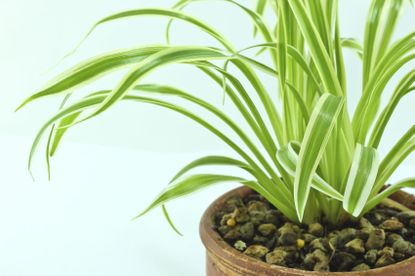Spider Plant Gnats: What To Do About Fungus Gnats On Spider Plants


Fungus gnats on spider plants are definitely an annoyance, but the pests, also known as soil gnats or dark winged fungus gnats, typically cause little damage to indoor plants. However, if you’re tired of spider plant fungus gnats terrorizing your prized plant, help is on the way.
Do Fungus Gnats Harm Spider Plants?
Fungus gnats are attracted to spider plants and other indoor plants because they like organic soil and warm, humid conditions. Fungus gnats are nuisances, but they generally don’t harm plants. However, certain species of fungus gnats lay eggs in the soil where the larvae feed on the roots or, in some cases, may even burrow into the leaves and stems. This is when some type of fungus gnat control is needed, as the larvae can be harmful in large numbers, and may damage plants or stunt plant growth. Young plants, as well as seedlings or newly propagated cuttings, are most susceptible. An adult fungus gnat lives only a few days, but a female can lay up to 200 eggs during her short lifespan. Larvae hatch in about four days and feed for a couple of weeks before pupating. After another three or four days, they emerge as the next generation of flying spider plant gnats.
Fungus Gnat Control on Spider Plants
If you are looking for ways to control annoying soil gnats in your spider plants, the following tips should help:
- Move infested plants away from healthy plants.
- Be careful not to overwater, as fungal gnats like to lay eggs in damp potting mix. If your spider plant is infested, allow the top 2 to 3 inches (5-8 cm.) to dry. Always pour out any standing water remaining in the drainage tray.
- Repot a severely infested spider plant into a clean container with fresh potting soil. Be sure the container has a drainage hole.
- Yellow sticky traps are an effective way to catch adult fungus gnats before they have an opportunity to lay eggs. Cut the traps into small squares and attach the squares to wooden or plastic sticks, then insert the sticks into the soil. Change the traps every few days.
- Apply B-ti (bacillus thuringiensis israelensis). The bacterial insecticide, which is different from regular Bt, is available in products such as Gnatrol or Mosquito Bits. Control is temporary and you may need to reapply B-ti every five days or so.
- Some people find that homemade solutions are effective for fungus gnats on spider plants. For example, fill small jars halfway with vinegar and a drop or two of liquid dish soap, then poke several holes in the lid (large enough for adult flies to enter). The flies, attracted to the vinegar, fly into the trap and drown.
- You can also place several slices of raw potatoes on the soil surface. Lift the slices after about four hours to check for larvae. This solution is probably most effective when used in conjunction with other fungus gnat control techniques.
- If all else fails, apply a pyrethrin insecticide to the soil surface. Although pyrethrin is a lower toxicity product, it’s still important to use and store the insecticide strictly according to label recommendations. It’s a good idea to apply the insecticide outdoors, then wait a day before bringing the spider plant back inside.
Gardening tips, videos, info and more delivered right to your inbox!
Sign up for the Gardening Know How newsletter today and receive a free download of our most popular eBook "How to Grow Delicious Tomatoes."

A Credentialed Garden Writer, Mary H. Dyer was with Gardening Know How in the very beginning, publishing articles as early as 2007.
-
 Grow a Bathroom Oasis: 8 Best Bathroom Plants With No Light or Low Light
Grow a Bathroom Oasis: 8 Best Bathroom Plants With No Light or Low LightSome apartment dwellers grow the best bathroom plants with no light or low light. Read how one of our favorite plant lovers does it in the big city.
By Teo Spengler
-
 "My Worst Mistake" – Gardeners Share 10 Hard-Learned Lessons
"My Worst Mistake" – Gardeners Share 10 Hard-Learned LessonsGardeners never stop learning, and sometimes our mistakes are the best teachers. But why not save time and heartache by learning from other gardeners' failures?
By Melanie Griffiths